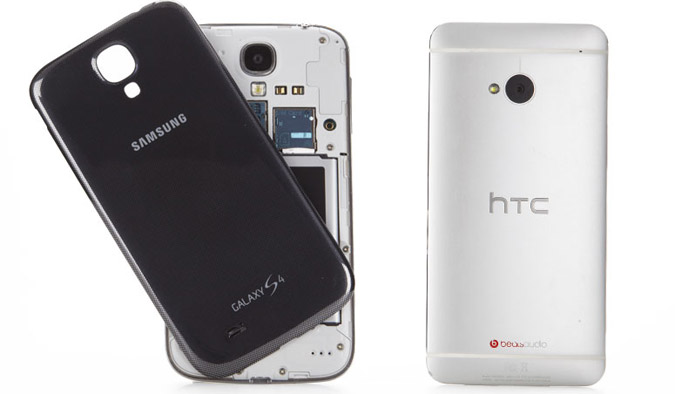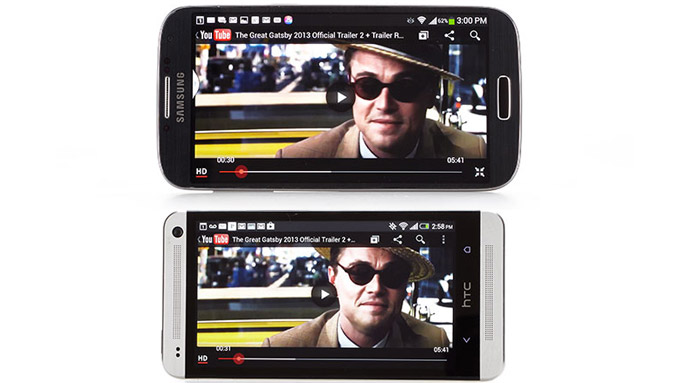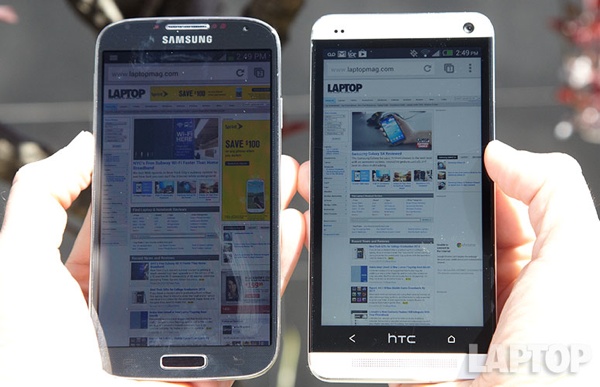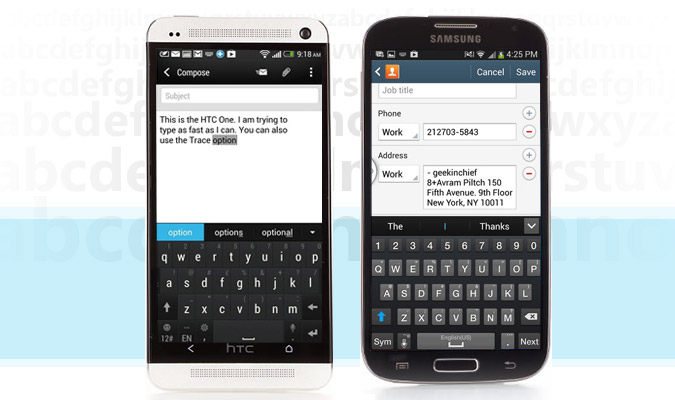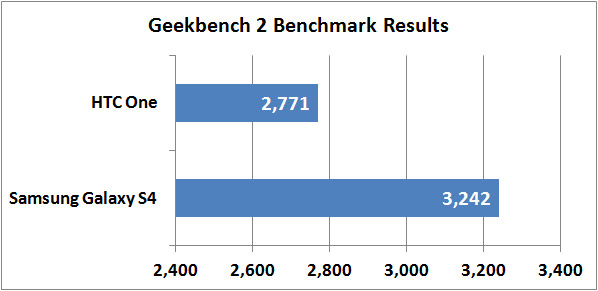Samsung Galaxy S4 vs. HTC One: The Mother of All Android Battles
With all the talk about the Galaxy S4 versus the iPhone 5, it's easy to forget that Samsung's flagship product faces serious competition from other Android phones. The HTC One is at the top of that list of adversaries. From its jaw-dropping aluminum design to its BoomSound speakers, the One is ready to challenge the S4 for smartphone supremacy. Then again, the Galaxy S4 has so many "wow"-inducing innovations stuffed into its slim frame that it redefines cutting edge.
So which superphone will win this battle? We pit the S4 against the One in nine rounds of competition to determine an Android champ.
Editors' Note: We originally published a preview face-off between the Galaxy S4 and the HTC One before both phones were commercially available. We have since added more rounds and more direct comparisons between the two devices. As a result, the final outcome is different.
Design
The HTC One is absolutely gorgeous, sporting a zero-gap aluminum design that rivals the iPhone 5 in terms of fit and finish. The curved back makes the device easy to hold, even if this 4.7-inch handset is on the hefty side. Add in polished, chamfered edges, spun metal volume controls and etched antennas on the back and you have the most beautiful Android phone yet.
MORE: Samsung Galaxy S4 Review and HTC One Review
With its polycarbonate (plastic) design, the Samsung Galaxy S4 feels solid in the hand, but doesn't have the same premium look or feel as the One. However, Samsung's device is thinner and lighter than HTC's phone, even though it has a larger display (5 inches versus 4.7 inches). We also like that the power button is easier to reach on the S4; it's on the right side, compared to the top left on the One.
Sign up to receive The Snapshot, a free special dispatch from Laptop Mag, in your inbox.
The S4 measures 5.38 x 2.75 x 0.31 inches and weighs 4.6 ounces, while the One weighs 5.1 ounces and measures 5.4 x 2.68 x 0.36 inches. The Galaxy S4 also has a removable back, which allows you to change batteries, add a microSD card or replace the battery with a wireless charging case.
Winner: HTC One. The Galaxy S4 is slimmer and lighter, but the HTC One runs circles around Samsung in terms of aesthetics and overall build quality. The One feels more like a flagship phone.
MORE: 10 Best HTC One Cases
Display
Now that full HD (1080p) screens are practically standard on high-end phones, device makers need to make their wares stand out in other ways. Still, the pixels per inch can make a difference in terms of how sharp that display looks. Here, HTC has the edge, because it crams 1920 x 1080 pixels into a 4.7-inch Super LCD 3 screen; that translates to 468 ppi, compared with 441 ppi for the Galaxy S4's Super AMOLED panel.
The HTC One outshines the Galaxy S4 in another way: brightness. When we hit both phones with our light meter, the One registered 463 lux and the S4 mustered 296 lux, comparable to the smartphone category average of 299 lux. This brightness gap was most evident when viewing the two handsets side by side in direct sunlight; although the One suffers from some glare, the S4's dimmer display was tougher to read.
What the S4's screen has going for it is deeper black levels and more saturated colors, which some users prefer when viewing photos and videos. When watching the high-def trailer for "The Avengers," greens and fiery orange explosions really popped on the Samsung. However, in darker scenes, we could make out finer details much more easily on the brighter One, such as the stitching and folds in Black Widow's uniform.
Winner: HTC One. While we love the eye-popping color on the S4, the One's screen is significantly brighter, making the panel easier to read outdoors.
Audio
If you're going to market your phone with a name like BoomSound, you had better back it up. The HTC One does just that, with dual-stereo speakers powered by Beats Audio. In our testing, the handset provided amazingly loud and clear sound at just a little over half-volume. Seriously, an external speaker is almost redundant when listening to your favorite tunes on Spotify or Pandora. Plus, because the speakers flank the display, you're unlikely to cover them up with your thumbs when gaming.
The Galaxy S4 has just a single speaker on its back, which provided loud but tinny audio in our tests. The sound can also get muffled when you place the phone on a desk or hold it in your hand. The audio quality wasn't nearly as rich or loud when we played the same "Paradise" track on both phones. The One's dual speakers are just better.
Winner: HTC One. If sound quality matters to you, the One will rock your world.
MORE: 25 Best Android Apps
Interface
On the surface, the TouchWiz interface on the Galaxy S4 doesn't look much different than the S3's, but how you interact with this device has changed dramatically. Using Air Gestures, you can change music tracks, flip through photos and answer the phone just by waving your hand in front of the S4's camera. Just keep in mind that your hand needs to be very close to the device.
Meanwhile, Air View allows you to preview info by hovering your finger above the display (no pen required). We found this feature especially useful for previewing emails, but sometimes the device gave us a hover action when we were trying to press to select.
The S4 can also track your eyes to pause videos (Smart Pause) when you look away from the screen, and you can scroll content (Smart Scroll) by either tilting the phone in your hand as you view a Web page or tilting your head. It's pretty amazing to scroll a Web page just by moving your head up or down, but the S4 was oversensitive at times.
While not as exciting, Multi View is super-useful, allowing you to run a number of apps side by side on the same screen. Just drag one app over from the left and you can start going through your inbox while you surf the Web. Or you can check Twitter while you watch a YouTube video.
The S4 has a big advantage over the One when it comes to the notification window. Owners can easily toggle Wi-Fi, Blocking Mode (for when you don't want to be bothered with notifications), Mute, Screen Rotation and Bluetooth. By pressing a grid button in the top right corner, you can access a total of 19 shortcuts. Yes, it's a little dizzying at first, but we love having all of these options at our fingertips. The notification menu on the HTC One is too bare-bones by comparison, offering just a toggle for the Power-saver Mode and a settings button shortcut.
The new Sense interface on the HTC One offers a new BlinkFeed feature that streams headlines and social updates right to your home screen. There's no question that there's some Windows Phone influence here, combined with a sprinkle of Flipboard. You can choose from multiple media brands, such as The Huffington Post and ESPN, or select more general categories like Politics or Technology. If you find BlinkFeed too busy, you can always opt for a traditional-looking home screen, and access BlinkFeed with a swipe.
The HTC One has a notable advantage over the S4,thanks to the One's proprietary recent-app menu. Double-tapping the home button lets you see up to nine apps at once, versus a few for Google's recent app treatment on the S4.
Otherwise, HTC Sense is definitely toned down versus previous versions — in a good way. The app menu on the One looks nice and clean, with plenty of black space among the apps for easy readability. You'll find the current weather conditions up top, shortcuts for search and the Google Play Store, and a Settings button for managing which apps appear and the size of the app grid. We also like how Sense integrates a settings button for apps into the software, as opposed to the S4's physical button.
Winner: Samsung Galaxy S4. HTC's BlinkFeed is sleek and customizable, and the Sense UI is refreshingly spare compared with TouchWiz. However, gesture support, Multi Window and easy access to important settings give Samsung the win in this round.
MORE: 10 Best Samsung Galaxy S4 Cases
Keyboard
Samsung comes out swinging in this round with the SwiftKey-powered keyboard on its S4. We love the fact that there's a dedicated number row above the letters, making it a cinch to enter passwords. The layout is also well-spaced, which cuts down on typos.
The best part of the S4's keyboard is the predictive text feature; it suggests words as you type and learns the more you use it. In fact, the S4 can learn from your contacts, along with your Facebook, Gmail, Twitter and Messaging apps. SwiftKey Flow allows you to swipe from letter to letter to enter words, but unlike the stand-alone SwiftKey app, you can't enter a string of words without lifting your finger.
The HTC One's keyboard offers larger letters, making targeting slightly easier as you type. You also get a tracing option for entering words. However, while you'll find autocorrection on board, the One doesn't offer next word prediction like the S4 does. You can always download SwiftKey, but we're evaluating the out-of-box experience here.
Winner: Samsung Galaxy S4. A dedicated number row and text prediction feature make the S4 just our (ahem) type.
MORE: 5 Best Keyboard Apps for Android
Camera
HTC and Samsung took vastly different approaches to their cameras for the One and Galaxy S4. The former smartphone emphasizes better low-light performance with its Ultrapixel camera, while the latter focuses on higher resolution and a bevy of clever features.
Let's start with the One, whose 4-megapixel Ultrapixel shooter uses a larger sensor than other phones to capture up to 300 percent more light. There's no question that the One does a better job capturing brighter images indoors in dim conditions, at least in Auto Mode. When we shot the same painting with very little ambient light, the S4's image was so dark it was hard to tell what the object was, but on the One, the swaths of multiple colors were clearly visible.
The HTC One beats the S4 when it comes to speed. Yes, both phones have a Burst Mode, but the One snapped individual photos almost instantaneously. The S4 exhibited a bit of lag, which could make it more difficult to catch moving subjects.
HTC includes a fairly unique feature in Zoes. A dedicated Zoe button in the camera app lets you capture 20 still frames along with 3 seconds of video. Plus, the camera starts a second before you press the button and finishes 2 seconds after you press stop, which means you're less likely to miss that moment. From there, you can share your Zoes on social networks, which redirect to zoeshare.htc.com.
While amusing, we prefer the longer 9-second clips the S4 provides with its Animated Photo Mode. You can animate the part of the image you want, and Samsung uses GIFs instead of a proprietary format.
MORE: 10 Best Android Apps You're Not Using
The Galaxy S4 comes to this round bearing a 13-MP back camera and 2-MP front camera. In most situations, the S4 trounced the One's 4-MP shooter because it delivers so much more detail, especially once you zoom in. In one image we took on our office building roof of the New York City skyline, a dome off in the distance looked muddy and fuzzy on the One, while the S4's shot was crystal clear. In another shot we took of a fountain in Bryant Park, the One’s photo was slightly brighter, but not nearly as crisp.
The S4 isn't just about high resolution, though, but how Samsung is attempting to redefine the picture-taking experience. For example, with Dual Shot and Dual Recording, you can shoot images and videos using the front and back cameras at the same time. The idea is that the photographer can insert themselves into the shot, and they can choose from multiple fun themes. Another highlight feature is Eraser, which lets you remove unwanted subjects who have wandered into the frame as a photo bomb.
There's more. Drama Shot lets you capture multiple images of the same moving subject to combine them into a single photo. The HTC One offers a similar Sequence Shot feature, but it's buried within the editing menu of Zoes.
To test the 1080p camcorders on the HTC One and Galaxy S4, we shot the same footage of New York City traffic at the same time with the phones held side by side. As you can see from our footage, the S4 delivers richer colors, while the One's video looks a bit washed-out. Check out the red truck as it passes by.
Winner: Samsung Galaxy S4. The HTC One performs better in low light and shoots faster, but the Galaxy S4 pulls ahead with sharper photos, richer video and a ton of fun photo features.
Specs and Performance
| Row 0 - Cell 0 | HTC One | Samsung Galaxy S4 |
| Row 1 - Cell 0 | Row 1 - Cell 1 | Row 1 - Cell 2 |
| Screen Size (inches) | 4.7 | 5.0 |
| Resolution | 1920 x 1080 | 1920 x 1080 |
| Pixel Density (ppi) | 468 | 441 |
| Processor | 1.7-GHz QualcommSnapdragon 600quad-core | 1.9-GHz QualcommSnapdragon 600 quad-core |
| RAM | 2GB | 2GB |
| Internal Storage | 32GB, 64GB | 16GB, 32GB, 64GB |
| Battery | 2300mAh | 2600mAh |
The U.S. version of the Galaxy S4 and HTC One both feature Qualcomm's latest quad-core Snapdragon 600 processor, promising 40 percent better performance than the Snapdragon S4 Pro processor. The S4 houses a 1.9-GHz CPU, and the HTC One's processor runs at 1.7 GHz. Both handsets come with 2GB of RAM.
In our testing, the HTC One notched an overall score of 24,392 on the AnTuTu benchmark, which measures CPU, GPU, RAM and I/O performance. That's slightly below the Galaxy S4's score of 24,554.
We also ran Geekbench 2 on the Galaxy S4, which measures integer, floating Point, memory and stream performance. The device turned in a score of 3,242, which beats the One’s score of 2,771.
Last but not least for this face-off, we ran the fairly new (and very intensive) 3DMark benchmark on both phones, which stresses the GPU performance and includes a physics test for CPU performance. We used the 3DMark Ice Storm Extreme potion of 3DMark, which includes 1080p off-screen rendering. The Galaxy S4 came out slightly ahead, scoring 6,765 to the One’s 6,720.
So what about real-world performance? The One was actually snappier most of the time, whether we were opening the camera, unlocking the device to an app or exiting an app to the home screen. Same thing goes for opening and closing the notification drawer. We simply noticed more lag on the S4, even after we turned off features like animation for the lock screen and the S Voice home key shortcut. It’s not bad, but it was definitely noticeable.
MORE: 5 Ways to Speed Up Y our Android Phone in 5 Minutes
To further test performance, we applied the same Black and White filter to the same video on both the S4 and HTC One using the VidTrim app. We also had each phone transcode the video to 480p. The S4 finished in 6 minutes and 44 seconds , slightly faster than the One (6:48).
Uniquely, the S4 offers expandable memory with a microSD Card slot and a replaceable battery. The HTC One offers a sealed design with 32GB of memory to start, while the Samsung starts at 16GB.
Winner: HTC One. No, this is not a typo. Although the Samsung Galaxy S4 beat the HTC One on most benchmarks, the One was more responsive in everyday use. That means more to users.
Special Features
Couch potatoes, rejoice. Both the Galaxy S4 and HTC One ship come with an IR blaster on the top and software (powered by Peel) to help control your TV. Samsung goes the extra mile, though, by adding Samsung Hub integration for downloading movies or shows you might want to watch.
The HTC One also features Sense Voice, which leverage the two mics to compensate for ambient noise and boosts in-call voices. Other features unique to the One are covered elsewhere in this face-off, including BlinkFeed, BoomSound and Zoes in the camera.
Samsung piles on the features in the Galaxy S4, including the aforementioned Air Gesture and Air View features. S Translate can translate text and voices into nine different languages, while S Health can keep tabs on your steps taken and calories burned, as well as your diet and even the comfort of your environment. S Health will sync with Samsung's own accessories, such as the S Band (think Fitbit) and a scale.
There's a lot more the S4 offers, including Group Play for blasting a tune on multiple S4 phones at once (gimmicky) and S Voice Drive for doing more behind the wheel while you keep your eyes on the road (such as texting or playing a song). A new and improved Samsung Hub puts music, video, books and games all under one very slick roof, similar to iTunes.
Winner: Samsung Galaxy S4. Samsung's phone almost does too much, but most users will find at least a few unique features that will really resonate with them.
Battery Life
The Samsung Galaxy S4 not only has a larger battery than the HTC One (2,600 versus 2300 mAh), but it is also replaceable. That means you can purchase an additional battery and swap it out when you're running low, or you can purchase a third-party battery that offers more capacity once they become available. However, the HTC One offered longer endurance in our testing.
When we tested the Sprint Galaxy S4 using the carrier's not-yet-launched 4G LTE in New York, the device lasted a mediocre 5 hours and 49 minutes on the LAPTOP Battery Test, which involves continuous Web surfing on 40 percent brightness. When we enabled Power-Saving Mode, which throttles the CPU down and limits screen power, the phone lasted a very similar 6 hours and 5 minutes, about on par with the 6-hour smartphone category average.
On the same test, the HTC One lasted 6 hours and 12 minutes, about the same time as the Galaxy S4 in Power-Saving Mode. When we turned on the One's own Power Saver Mode, which limits CPU usage, reduces display brightness and puts the data connection to sleep when the display times out (though we kept the screen on), HTC's flagship lasted 7:20. That's more than an hour longer than the S4.
Winner: HTC One. While we like that the S4's battery is easily replaced, the HTC One lasts longer on a charge.
Overall Winner
Deciding between the Galaxy S4 and the HTC One is not an easy task, not just because both are positively awesome Android phones, but because they have very different strengths.
The Galaxy S4 is the most feature-rich phone ever made for any operating system. You will literally spend weeks (if not months) discovering all the cool things this device can do, from Air Gestures to Multi Window multitasking. The S4 also offers a better keyboard, easier access to settings and a sharper camera. On the other hand, the HTC One boasts a more premium design than the S4, better speakers and a brighter screen. I also found the One to be more responsive in everyday use.
The bottom line is that the HTC One and Galaxy S4 are the two best Android phones yet. It's up to you to decide which advantages and features have more value. But for me, the HTC One ekes out the victory because of its design, display and snappier performance.
Editor-in-chief Mark Spoonauer directs LAPTOP’s online and print editorial content and has been covering mobile and wireless technology for over a decade. Each week Mark’s SpoonFed column provides his insights and analysis of the biggest mobile trends and news. You can also follow him on Twitter and Google+.



